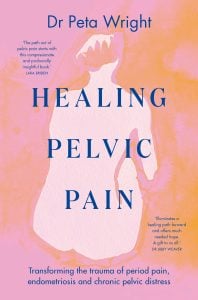At the recent World Endometriosis Congress in Sydney, a session entitled, “The Great Debate: To Make Progress We Must Rethink Our Approach to Endometriosis Research,” gave me the most hope.
Professor Michel Canis, grandfather of surgical techniques, thought leader and highly respected Giant in the Field, submitted that the greatest oversight in our current understanding of pelvic pain is our failure to acknowledge the contribution of trauma.
In an awkward segue, the “debate” proceeded as separate orations and this historical moment passed.
Rethinking your approach to pelvic pain and endometriosis? Read this book.
Dr Peta Wright’s thesis, supported by strong evidence, is that pain as a disability is, in part, a social problem, and that we ignore the contribution of the brain and environment at our peril. Focusing on endometriosis and adenomyosis is a nocebo which disempowers women, and a narrow biomedical, reductionist approach contributes to suffering. We cannot simply cut out inflammation.
Part one of the book covers endometriosis, medicines and surgery. Chapters 7-9 explain the neuroscience of pain, the role of the autonomic nervous system, trauma, polyvagal theory, which although a theory does pull it all together.
Dr Wright is clear to detail the enormous benefits of hormonal treatments, but she urges people to not swap one bunch of awful symptoms for another – the advantages must outweigh the disadvantages, and we must employ shared decision making.
Part two covers an action plan for healing with clear explanations of the role of pelvic health physiotherapists and psychologists trained in pain and trauma. Part three is the tip of Maslow’s hierarchy – making meaning and self-actualisation. The flare toolkit is comprehensive and a great resource for patients.
Her beautiful writing is full of metaphors, storytelling and visual imagery. It is easy to read, and there is little I don’t agree with. I suspect the book is written as much for a medical audience as for patients, and it will certainly be recommended reading for the new Pelvic Pain Special Interest Module for RANZCOG trainees.
For future editions, I’d like to see the references clearly indicated alongside the text and further explanation about the role of vaginal diazepam which is creeping into Australian practice. My anaesthetic colleagues tell me the dose for muscle relaxation typically requires intubation. If we are using this medicine as an anxiolytic, oral administration is cheaper and more predictable (also can we please stop putting untested things into people’s vaginas?).
A call to action: what year will it be when a doctor in Australia or Aotearoa New Zealand can clearly outline to a patient seeking care for pelvic pain the interconnected roles of the body, mind and environment? Let’s shorten the “Green Gap” detailed by Lawrence in 2014 and grab yourself a copy!

References
- Green, L.W. 2014 Closing the chasm between research and practice: evidence of and for change. Health Promotion J. of Australia. 25(1): 25-29. https://onlinelibrary.wiley.com/doi/full/10.1071/HE13101






Leave a Reply